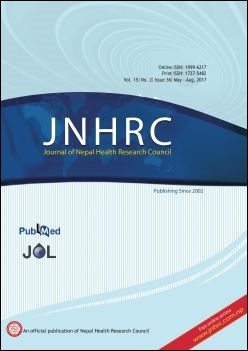Profile of Caesarean Section at Kathmandu Medical College
Keywords:
Caesarean section, indication, rate of caesarean section.Abstract
Background: There is a world-wide rise in caesarean section rateduring the last three decades and has been a cause of alarm and needs an in-depth study. The objective of this study was to determine the rate and clinical indications of Caesarean Section.
Methods: A hospital based study was carried out from 15th June 2015 to 15th January 2016 in Department of Obstetrics and Gynecology at Kathmandu Medical College, Sinamangal, Nepal. Patients who delivered by caesarean section were included in the study. Basic demographic data and clinical indications were noted.
Results: A total of 1172 deliveries were carried out during the study period. Total number of caesarean section was 537 accounting to 45.81%. Most of the patients were of the age group of 25-29 years (42.8%). Most of the patients were primigravida (n=274; 51%). Emergency caesarean section was 411 (76.5%) and elective caesarean section was 126 (23.4%). Multigravida (71%) underwent more elective procedure than primigravida (25. 39%).The most frequent indication was fetal distress19.55% (n=105), failed induction 19.73%(n=106), and previous caesarean section 21.3% (n=115).
Conclusions: The rate of cesarean section is quite high than that recommended by WHO which is (10-15%). Most of the caesarean sections were emergency caesarean section with previous caesarean being the leading cause.
Downloads
Downloads
Published
How to Cite
Issue
Section
License
Submission of the manuscript means that the authors agree to assign exclusive copyright to JNHRC. The aim of JNHRC is to increase the visibility and ease of use of open access scientific and scholarly articles thereby promoting their increased usage and impact. Hence, JNHRC grants permission to read, download, copy, distribute, print, search, or link to the full texts of these articles which is available online (http://jnhrc.com.np) freely.
The articles in this journal are licensed under a Creative Commons Attribution 4.0 International License.

